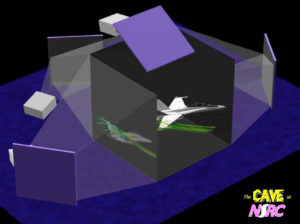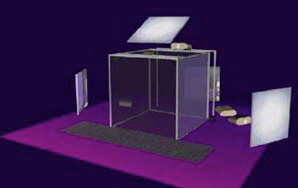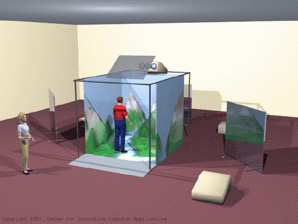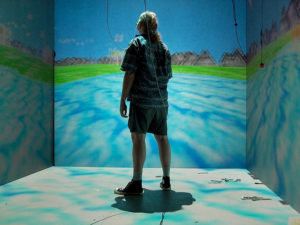Chapter 17: Virtual Environments
17.5 Virtual Spaces

LEEP Optical System started to develop wide angle lenses for 3-D still photography applications in 1975. The Large Expanse, Extra Perspective (LEEP) optical system was designed by Eric Howlett in 1979 and provided the basis for most of the virtual reality helmets that were developed. The combined system gave a very wide field of view stereoscopic image. The users of the system were impressed by the sensation of depth in the scene and the corresponding realism.
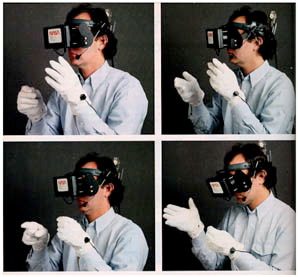
The original LEEP system was redesigned for the NASA Ames Research Center in 1985 for their first virtual reality installation, the VIEW (Virtual Interactive Environment Workstation) by Scott Fisher. The system was built according to lessons learned using the LEEP display earlier, and proved to be quite impressive. It already featured many techniques that were often used: a Polhemus tracker, 3D audio output, gesture recognition using VPLs DataGlove, a remote camera, and a BOOM-mounted CRT display.

In 1988 Fakespace began building a telepresence camera system for the Virtual Environment Workstation (View) project at NASA Ames Research Center. The complete system combined a teleoperated camera platform and 3D viewing system.To increase image quality, Fakespace invented the BOOM (Binocular Omni-Orientation Monitor). Very small monitors were mounted on a mechanical arm, and users looked into the monitors like they would look into a pair of binoculars. Tracking occured when the user moved the arm, which changed the perspective. When a user released the BOOM, another person could look at the same thing from the same perspective, which was an advantage over HMDs. Since real monitors were used, the resolution was quite good.
The concept of a room with graphics projected from behind the walls was invented at the Electronic Visualization Lab at the University of Illinois Chicago Circle in 1992. The images on the walls were in stereo to give a depth cue. The main advantage over ordinary graphics systems was that the users were surrounded by the projected images, which means that the images were in the users’ main field of vision.
This environment was called a “CAVE”, (CAVE Automatic Virtual Environment). The first CAVE (as well as the concept) was created by Carolina Cruz-Neira, Dan Sandin, and Tom DeFanti, along with other students and staff of EVL. This back-projection method of virtual reality gained a strong following.
The CAVE was a surround-screen, surround-sound, projection-based virtual reality (VR) system. The illusion of immersion was created by projecting 3D computer graphics into a 10’x10’x10′ cube composed of display screens that completely surrounded the viewer. It was coupled with head and hand tracking systems to produce the correct stereo perspective and to isolate the position and orientation of a 3D input device. A sound system provided audio feedback. The viewer explored the virtual world by moving around inside the cube and grabbing objects with a three-button, wand-like device.
Unlike users of the video-arcade type of VR system, CAVE dwellers did not wear helmets to experience VR. Instead, they put on lightweight stereo glasses and walked around inside the CAVE as they interacted with virtual objects. Multiple viewers often shared virtual experiences and easily carried on discussions inside the CAVE, enabling researchers to exchange discoveries and ideas. One user was the active viewer, controlling the stereo projection reference point, while the rest of the users were passive viewers.
The CAVE was designed from the beginning to be a useful tool for scientific visualization; EVL’s goal was to help scientists achieve discoveries faster, while matching the resolution, color and flicker-free qualities of high-end workstations. Most importantly, the CAVE could be coupled to remote data sources, supercomputers and scientific instruments via high-speed networks. It had obvious benefits: it was easy for several people to be in the room simultaneously and therefore see images together; and it was easy to mix real and virtual objects in the same environment. Also, because users saw, for example, their own hands and feet as part of the virtual world, they got a heightened sense of being inside that world.
Various CAVE-like environments existed all over the world. Most of these had up to four projection surfaces; images were then usually projected on three walls and the floor. Adding projection on the ceiling gave a fuller sense of being enclosed in the virtual world. Projection on all six surfaces of a room allowed users to turn around and look in all directions. Thus, their perception and experience were never limited, which was necessary for full immersion. The PDC Cube at the Center for Parallel Computers at the Royal Institute of Technology in Stockholm in Sweden was the first fully immersive CAVE.
For a discussion of VR devices, see
Review of Virtual Environment Interface Technology, IDA Paper P-3186, by Christine Youngblut, Rob E. Johnson, Sarah H. Nash, Ruth A. Wienclaw, and Craig A. Will
Virtual Reality in Training and Education: Resource Guide to Citations and Online Information
Gallery 17.1 CAVE Environments
- A diagram of the CAVE at the National Supercomputing Research Center (NSRC). The CAVE (CAVE Automatic Virtual Environment) was developed by DeFanti, et al at the University of Illinois. This CAVE installation is an enclosed 10 feet cube room-sized advanced visualization tool that combines high-resolution, stereoscopic projection and 3D computer graphics to create the illusion of complete immersion in a virtual environment.
- CAVE environment
- CAVE installed at IU
- Crayoland
